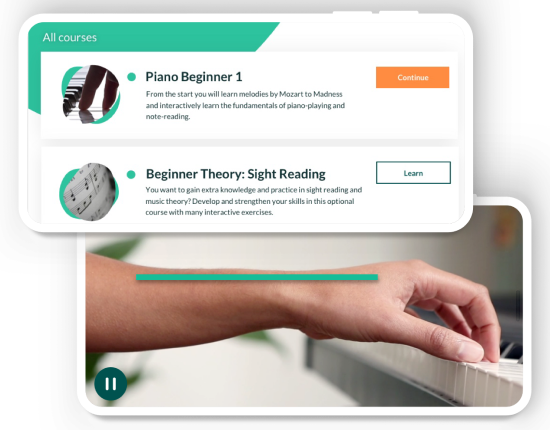Table of Contents
At the heart of captivating piano playing lies a fundamental element: technique. It’s the cornerstone that transforms mere notes into soul-stirring music. Good technique is not just about playing notes correctly; it’s about doing so with ease, efficiency, and expressiveness. It enables pianists to communicate emotions, create varying sound textures, and bring compositions to life with their unique interpretation.
To improve piano technique, a multifaceted approach is necessary. It’s not just practicing more, but practicing right. This includes developing finger strength and agility, mastering chord patterns, enhancing rhythmic precision, and cultivating expressive playing. Each aspect contributes to a holistic development, allowing pianists to play more challenging pieces with greater artistry and confidence.
In this comprehensive guide, you will find the answer to the question, “How to improve piano technique.” We’ll explore essential daily exercises, advanced techniques for skill development, and strategies for expressive playing and rhythm mastery. We’ll also delve into the ergonomics of playing and effective practice habits, along with the importance of guidance and feedback in this journey.

Fundamental techniques for daily practice
For the aspiring pianist, daily practice is not just a routine; it’s a ritual to hone the craft. This section focuses on the essential exercises that lay the groundwork for advanced piano technique.
Essential daily exercises
- Scales: The backbone of piano technique, scales are crucial for developing finger strength and agility. Practicing piano scales in different keys helps in understanding the keyboard layout and improves hand coordination.
- Arpeggios: These are vital for enhancing finger dexterity and for understanding piano chord structures. Regular practice of arpeggios aids in smoother transitions between notes.
- Chords: Familiarity with chord shapes and progressions is essential. It not only aids in playing a wide range of music but also in improvisation and composition.
Building finger strength and agility
Finger strength and agility are pivotal for executing complex passages with precision. Incorporating exercises like Hanon’s “The Virtuoso Pianist” or Czerny’s studies can significantly improve finger independence and control. Remember, the goal is not speed but clarity and evenness in tone.
Mastering chords and patterns
Understanding and mastering various chord patterns, including broken chords and cadences, is fundamental. This not only enhances technical skill but also deepens musical understanding. Practice different chord inversions and progressions to build versatility and adaptability.
Summary of the video
The video presents three fundamental exercises for beginner pianists, emphasizing their simplicity yet potential to significantly enhance piano playing skills. These exercises are also useful for more experienced players due to their underlying complexity.
- Basic five-note scale exercise
- Variations on the five-note scale
- Hanon exercises
Additional insights:
- The video emphasizes the importance of smooth transitions between piano notes, avoiding overlapping or gaps.
- A focus is placed on minimal and efficient finger movement, avoiding unnecessary strain.
Advanced techniques for skill development
As pianists progress, they encounter more complex pieces that demand advanced techniques. This section explores how to tackle these challenges and refine your piano skills.
Challenging pieces and articulation
- Selecting challenging repertoire: To grow as a pianist, it’s crucial to gradually introduce more challenging pieces into your practice. These pieces often contain intricate passages, demanding rhythms, and complex harmonies that push your technical and musical boundaries.
- Focus on articulation: Paying attention to articulation marks like staccato, legato, and accents is vital. They are not just symbols but keys to unlocking the emotion and character of a piece. Practice them diligently to bring out the composer’s intended expression.
Sight reading for versatility
Sight reading is an invaluable skill that enhances your ability to learn new pieces quickly and adapt to different musical styles. It involves:
- Regular practice: Dedicate a portion of your practice time to sight reading. Start with simpler pieces and gradually increase the difficulty.
- Reading ahead: Train your eyes to read a few notes or measures ahead of where you’re playing. This helps in anticipating what’s coming next and prepares your hands accordingly.
Expressive playing and rhythm mastery
Expressive playing and rhythmic precision are what separate good pianists from great ones. They are the essence of music-making.
Emotional expression through dynamics
Music dynamics are not just about playing loud or soft; they’re about conveying the story and emotions of a piece. Practice varying your touch and volume to create contrasts and shades in your playing. This will bring depth and emotion to your performances.
Rhythmic precision and timing
Rhythm is the heartbeat of music. To master it:
- Use a metronome: It’s an essential tool for developing a strong sense of timing and rhythm.
- Count aloud: This helps internalize the rhythm and improves your timing, especially in complex or syncopated passages.

Ergonomics and effective practice habits
Ergonomics and effective practice habits are crucial for long-term development and injury prevention. This section provides guidelines for maintaining proper posture and designing efficient practice routines.
Proper hand and finger positioning
- Hand posture: Keep your wrists flexible and slightly elevated. Avoid tension and ensure your fingers are curved, using the tips to strike the piano keys.
- Finger positioning: Each finger should move independently, with a focus on using the correct finger for each note. This promotes accuracy and speed.
Efficient practice routines
Creating an effective practice routine is key to progress. Use these tips to improve piano technique:
- Set clear goals: Define what you want to achieve in each session, whether it’s mastering a particular passage or improving your rhythm.
- Quality over quantity: It’s better to have focused, productive practice sessions than long, unfocused ones. Aim for consistency.
- Incorporate variety: Mix technical exercises with pieces and sight-reading to keep your practice sessions engaging and well-rounded.
- Regular breaks: Take short breaks to prevent fatigue and maintain concentration.
Seeking guidance and feedback
While self-study is valuable, guidance from a teacher or mentor can significantly accelerate your learning curve.
A teacher provides personalized feedback, helps in identifying areas for improvement, and offers insights that you might not discover on your own. They can tailor exercises to your specific needs and help you interpret pieces more effectively.
Self-evaluation and improvement
- Recording your practice: Listening to recordings of your playing can reveal nuances and areas that need improvement.
- Setting milestones: Regularly set and review goals to track your progress and stay motivated.
Integrating techniques for holistic development
Remember, the path to piano mastery is a continuous journey of learning and growth. Each practice session, each piece you master, and each challenge you overcome adds to your musical tapestry. Embrace the process with patience, dedication, and passion.
As you continue to refine your technique, consider exploring resources like Skoove’s structured online piano lessons that align with the principles discussed in this guide, making it an excellent companion on your musical journey.
In closing, whether you’re playing for personal enjoyment or aspiring to perform on stage, the joy of piano playing lies in the journey itself. Keep exploring, keep learning, and let the music flow from your heart through your fingers to the piano keys.
Author of this blog post:

Eddie Bond is a multi-instrumentalist performer, composer, and music instructor currently based in Seattle, Washington USA. He has performed extensively in the US, Canada, Argentina, and China, released over 40 albums, and has over a decade experience working with music students of all ages and ability levels.














